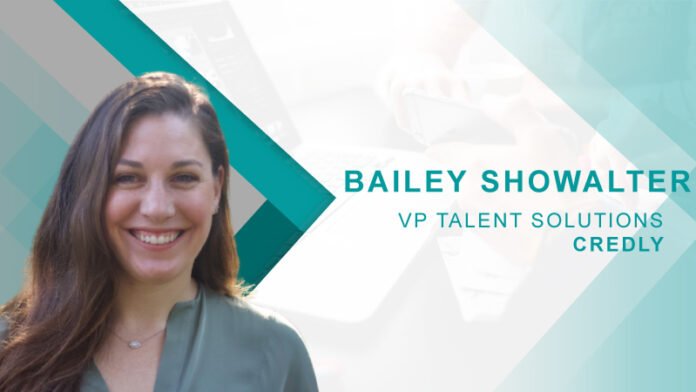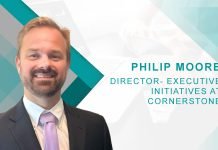Bailey is a Multi-disciplinary leader with expertise in bringing new product solutions to market. She is an avid reader, runner, and pet mom.
1. Tell us about your role at Credly?
Most earners and learners of digital credentials are interested in a positive career outcome after earning a credential. For some, this could be anything from earning a promotion to compliance with keeping your job. For others, this could entail searching for job opportunities outside of your organization, industry, or turning these credentials into college credits and earning a degree. My role at Credly is focused on those external opportunities and helping credential earners take their next step if an external opportunity arises. With this, I am leading the Credly Talent Solutions team to help people connect to the right opportunity at the right time based on their verified skills.
2. Can you tell us about your journey into this market?
I’ve spent the bulk of my career working on how technology can help people find their next opportunities. One of the reasons I was, and remain, so excited to be a part of this journey with Credly is the foundation in skills. Throughout my career, the constant refrain from job seekers has been “my resume doesn’t tell my story — just let me show you what I can do [or know]!” Because Credly is a credentialing platform first, what we know about people when they’re looking for new opportunities is really rooted in those proven skills. In other words, it’s rooted in what they can do, and what they know.
3. What do you think is the biggest technological challenge in HRTech industry right now?
There are no shortages of technological challenges in HRTech, but broadly, I see major gaps in the tools that help employers understand how to recruit, upskill, and promote based on their teams’ skills. With current tools, it’s very difficult to understand the skill profile of talent and where to go from there, which hamstrings employers’ ability to best help their talent grow.
4. How has data-driven approach empowered HR professionals?
A quote I’ve often heard around this is that “you can’t improve what you can’t measure.” A data-driven approach allows HR teams to deploy their time and energy towards tools and programs that provide the best outcomes for their teams, ultimately helping them identify strategic gaps that they can help correct.
A hot topic for this has been around improving DE&I initiatives internally. For many years, there was a minimal focus on the make up of talent pipelines and the employee base, much less which programs were most engaging for underrepresented populations. Leveraging data helps identify the blind spots in processes and work to improve them over time.
5. How companies can eliminate gender bias in the workplace through upskilling and reskilling?
Progress toward gender equality has been gradual, yet certain industries still remain dominated by men. For example, in the tech industry, leadership positions continue to be held by males where only 10% of executive roles were held by females in 2020. By providing opportunities to reskill and upskill employees, organizations can find a more gender-balanced leadership pipeline to ensure opportunities for women in the workforce.
The days where earning a degree means your education journey has ended are no longer applicable. The world is changing so quickly that, ultimately, those most qualified for the next steps are the ones who are continuously focused on their own independent learning journey.
Micro- learning and continued education provide a lower barrier of entry for people to continue to stay ahead of trends and learn the necessary skill sets to advance in their careers. By allowing employees to upskill or reskill, they have the opportunity to be evaluated for the next steps of their career on an equal level to others, especially on the basis of what they know and what skills they have. For companies, focusing on skill sets as the key determinant of promotions provides a level playing field for the right person to receive the position, eliminating potential biases in the determining process.
6. How reskilling is a form of self-care?
The act of self-care is a necessity for good, well-rounded, health and putting value in yourself. An important, but overlooked, form of self-care is investing in your skills and career growth. Upskilling and reskilling does not have to be a linear experience, but it can be exploring interests and learning new things consistently. By putting value in yourself by learning new skills and exploring the topics and items that interest you, you are setting yourself up to be a valuable asset in your organization but also allowing yourself the chance to set yourself up for success and be where you want to be in your career.
7. How the modern-day resume is not sustainable for the current hiring landscape?
The resume is the currency for hiring, yet the resume — as it is now —is out of date for the modern hiring landscape. Where traditionally, previous work experience has held the most value and took precedence as the biggest section on a paper resume, it no longer tells the full story to employers in today’s environment.
Instead, job seekers should make their skills and credentials the main focus when applying to jobs, and employers should shift their expectations of employee skills from nice-to-haves to must-haves and focus on a skills-based hiring approach. Especially with many people shifting jobs or career industries altogether right now, their previous experience may not be applicable to the new position, but the skills they have learned from leading teams or working with specific tools could be.
8. What are the biggest changes you expect to see in the HRTech industry in the next few Years?
As big data comes to the table in a major way, I expect to see more understanding of our full talent pipeline. From pre-hire engagement through interviewing, onboarding, upskilling, internal mobility, offboarding, and engagement again, we struggle to interact with our talent pools in the right ways consistently. As we bring more knowledge about total career pathing, I expect to see major shifts in the way we think about talent as supported by technology and data.
9. What advice would you like to give to technology startups?
Build with intentionality, both your technology and your teams. Especially in HRTech, when we’re dealing with real career outcomes as outputs from our technologies, we need to thoughtfully consider whether we are helping, hurting, or neutral in the development of our tools. AI and machine learning are only as unbiased as we teach them to be, so ensuring that thoughtfulness goes into our early teams and products helps set us up for longer-term success.
10. What work-related hack do you follow to enjoy maximum productivity?
Honestly, my biggest productivity hack is ensuring time for the things that keep me sharp: sleep, exercise, and food. It’s not uncommon for people to see hour blocks on my calendar for “gym time” or “lunch,” and I am fanatic about going to bed early enough to get a full night’s sleep for my next day. When I undersleep, skip lunch, and sit in a chair all day, I can feel the fogginess creep in for my afternoon meetings, and no one gets the best version of me. To ensure that I’m able to be sharp all day, I really prioritize those wellness foundations, even when they feel like easy blocks to schedule over to fit in more meetings.
11. How do you prepare for an AI-Centric world?
With intentionality. AI is inherently vulnerable to the biases we bring to the table when writing these algorithms, so it is critical that we have diverse teams contributing to balance out the perspectives going into these models.
12. Can you tell us about your team and how it supports you?
My team is wonderful, and I feel privileged to work with them every day. My philosophy has long been to hire folks who are brilliant in their fields and then to get out of their way so they can do what they do best. Ultimately, my job is to set the vision clearly and then eliminate their roadblocks, and I like to give them a lot of latitude to bring their creativity and unique perspectives to the problems we’re solving.
13. What movie inspires you the most?
Stand and Deliver is a go-to for me. I was blown away by the transformation of radical belief in someone (or a class) when I first saw it, and when I found it was based on a real teacher in a real school, I was further astounded. It was the first time I saw how big of an impact one person at the right time can really have on someone’s life, and it helped inform how I view the importance of equitable access to education and opportunities for underrepresented communities.
14. We have heard that you have a very joyful work culture, so can you share with us some of the fun pictures of your workplace?
Credly is certainly a fun place to be, whether we’re collaborating remotely, on-site in one of our office spaces, or during a team-building event. Here are a few pictures of the Credly team collaborating in the office and giving back to our local communities – dropping off toys at a local holiday toy drive and working with the Twin Cities Habitat for Humanity.

15. Can you give us a glance of the applications you use on your phone?
Despite this chaos, I actually use fewer than you’d probably think. The ones most recently opened are Slack, Gmail, Instagram, Google Maps, and Photos. Mostly I use my phone to get around and to check in with folks, but my actual work gets centered on my laptop.


Bailey Showalter VP Talent Solutions, Credly
Bailey is a Multi-disciplinary leader with expertise in bringing new product solutions to market. She is an avid reader, runner, and pet mom.













